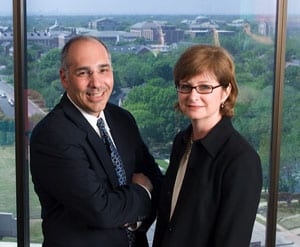 SMU’s Department of Psychology and The Guildhall at SMU have joined forces against dating violence.
SMU’s Department of Psychology and The Guildhall at SMU have joined forces against dating violence.
Psychology Professors Ernest Jouriles and Renee McDonald, with Guildhall Lecturer Jeff Perryman and Deputy Director Tony Cuevas, are collaborating on a role-playing program that combines virtual reality with behavioral insight to help teach and test sexual assault avoidance techniques.

The program’s environment of a rain-lashed car parked in an isolated area immerses women into not just a location, but also a “conversation” with a potential attacker.
It is the first step in what developers hope will be a program to help women practice strategies for averting sexual assault in a controlled situation that is safe, yet feels realistic.
“This is a potential breakthrough opportunity for gaming technology to help solve an important social problem,” Jouriles says.
During one session, the experience starts in a small, nondescript office where two automobile seats are bolted to a raised platform: An actor sits in the driver’s seat, and a woman sits in the passenger seat to his right. When she puts on video goggles and a headset, she suddenly finds herself in a parked car during a howling rainstorm. Rivulets of water stream down the windshield, flashes of lightning illuminate the interior of the car, and thunder beats a steady cadence.
She doesn’t see the actor beside her, she sees a three-dimensional video game character at the wheel of the car. She is drawn into small talk, but the driver turns increasingly aggressive, eventually demanding sexual intimacy. It is nothing short of frightening and, oddly enough, very real.
Role-playing is a well-established method for teaching people to deal with complex social situations, says Jouriles, professor and chair of psychology in Dedman College. But he hit a wall in his research when he tried the method to teach relationship violence avoidance techniques to a high school health class in the late 1990s.
“The role-playing produced giggles,” Jouriles says. “And from my perspective, it didn’t capture the imaginaton of the students.”
 |
| SMU psychologists Ernest Jouriles and Renee McDonald. |
Jouriles and McDonald, associate professor of psychology in Dedman College, joined the SMU faculty in August 2003, when a handful of psychologists around the country were beginning to experiment with virtual programs to treat anxiety disorders, such as allowing people who were afraid of flying to “practice” without boarding an airplane.
They wondered whether SMU’s newly opened Guildhall could help teach and test sexual assault avoidance techniques by immersing a woman into not just a virtual location, but also a “conversation” with a potential attacker.
“We created an enclosed environment,” says Perryman, Guildhall lecturer, who worked on the program with Guildhall’s Cuevas.
“We wanted our participant to feel powerless. The rain was added to isolate her. The car is particularly creepy. We worked hard at that,” says Perryman.
The simulation requires participants to wear a head-mounted video display with tracking technology that senses head movements and an audio headset, which transmits the voice of the avatar “driver” and other sounds from the virtual environment. The avatar’s lips move in sync with the voice of the actor, who controls the character’s facial expressions and movements through a video keyboard. The virtual driver can be made to nod, shrug, even pound the steering wheel in anger when he is rebuffed.
Jouriles, McDonald and their team studied the responses of 62 undergraduate women who were randomly assigned to traditional or virtual reality role-play and outfitted with heart monitors. All were asked to complete questionnaires afterward on their moods and experience.
The women who donned the headgear and went through the virtual scenario rated the experience’s realism higher than those in the traditional role play group. Behavioral observations also suggested that women experiencing the virtual car scene appeared more angry and afraid.
Jouriles calls those results “very promising.” The next step, he says, is to develop a virtual scenario that can test techniques to avert sexual assault. He hopes to see some variation on the virtual program developed for use in high schools and colleges. — Kim Cobb
Related links:
SMU Profile: Ernest Jouriles and Renee McDonald
Ernest Jouriles
Renee McDonald
Jeff Perryman
Tony Cuevas
SMU Guildhall
SMU Department of Psychology
Dedman College of Humanities and Sciences
 Southern Methodist University psychology professor Alicia Meuret proves conventional wisdom is dead wrong: A person suffering a panic attack who tries deep breathing to calm themselves only increases his or her level of hyperventilation and overall panic-related symptoms.
Southern Methodist University psychology professor Alicia Meuret proves conventional wisdom is dead wrong: A person suffering a panic attack who tries deep breathing to calm themselves only increases his or her level of hyperventilation and overall panic-related symptoms.![]() Video: Hyperventilation
Video: Hyperventilation




 It is a discussion that seems familiar. But new findings show that people who travel frequently are more likely to experience déjà vu. Political liberals report more déjà vu experiences than conservatives do. And déjà vu becomes less common as people grow older.
It is a discussion that seems familiar. But new findings show that people who travel frequently are more likely to experience déjà vu. Political liberals report more déjà vu experiences than conservatives do. And déjà vu becomes less common as people grow older.